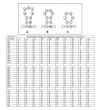The 3' sequences required for incorporation of an engineered ssRNA into the Reovirus genome
- PMID: 16390540
- PMCID: PMC1352349
- DOI: 10.1186/1743-422X-3-1
The 3' sequences required for incorporation of an engineered ssRNA into the Reovirus genome
Abstract
Background: Understanding how an organism replicates and assembles a multi-segmented genome with fidelity previously measured at 100% presents a model system for exploring questions involving genome assortment and RNA/protein interactions in general. The virus family Reoviridae, containing nine genera and more than 200 members, are unique in that they possess a segmented double-stranded (ds) RNA genome. Using reovirus as a model member of this family, we have developed the only functional reverse genetics system for a member of this family with ten or more genome segments. Using this system, we have previously identified the flanking 5' sequences required by an engineered s2 ssRNA for efficient incorporation into the genome of reovirus. The minimum 5' sequence retains 96 nucleotides and contains a predicted sequence/structure element. Within these 96 nucleotides, we have identified three nucleotides A-U-U at positions 79-81 that are essential for the incorporation of in vitro generated ssRNAs into new reovirus progeny viral particles. The work presented here builds on these findings and presents the results of an analysis of the required 3' flanking sequences of the s2 ssRNA.
Results: The minimum 3' sequence we localized retains 98 nucleotides of the wild type s2 ssRNA. These sequences do not interact with the 5' sequences and modifications of the 5' sequences does not result in a change in the sequences required at the 3' end of the engineered s2 ssRNA. Within the 3' sequence we discovered three regions that when mutated prevent the ssRNA from being replicated to dsRNA and subsequently incorporated into progeny virions. Using a series of substitutions we were able to obtain additional information about the sequences in these regions. We demonstrate that the individual nucleotides from, 98 to 84, 68 to 59, and 28 to 1, are required in addition to the total length of 98 nucleotides to direct an engineered reovirus ssRNA to be replicated to dsRNA and incorporated into a progeny virion. Extensive analysis using a number of RNA structure-predication software programs revealed three possible structures predicted to occur in all 10 reovirus ssRNAs but not predicted to contain conserved individual nucleotides that we could probe further by using individual nucleotide substitutions. The presence of a conserved structure would permit all ten ssRNAs to be identified and selected as a set, while unique nucleotides within the structure would direct the set to contain 10 unique members.
Conclusion: This study completes the characterization and mapping of the 5' and 3' sequences required for an engineered reovirus s2 ssRNA to be incorporated into an infectious progeny virus and establishes a firm foundation for additional investigations into the assortment and encapsidation mechanism of all 10 ssRNAs into the dsRNA genome of reovirus. As researchers build on this work and apply this system to additional reovirus genes and additional dsRNA viruses, a complete model for genome assortment and replication for these viruses will emerge.
Figures




Similar articles
-
Identification of the 5' sequences required for incorporation of an engineered ssRNA into the Reovirus genome.Virology. 2004 Nov 24;329(2):348-60. doi: 10.1016/j.virol.2004.08.026. Virology. 2004. PMID: 15518814
-
Localizing the reovirus packaging signals using an engineered m1 and s2 ssRNA.Virology. 2007 Feb 5;358(1):89-97. doi: 10.1016/j.virol.2006.08.017. Epub 2006 Sep 20. Virology. 2007. PMID: 16987539
-
Analysis of the terminal sequences of the genome segments of four orbiviruses.Prog Clin Biol Res. 1985;178:371-87. Prog Clin Biol Res. 1985. PMID: 2989875
-
Nonstructural proteins involved in genome packaging and replication of rotaviruses and other members of the Reoviridae.Virus Res. 2004 Apr;101(1):57-66. doi: 10.1016/j.virusres.2003.12.006. Virus Res. 2004. PMID: 15010217 Review.
-
Virus synthesis and replication: reovirus vs. vaccinia virus.Yale J Biol Med. 1980 Jan-Feb;53(1):27-39. Yale J Biol Med. 1980. PMID: 6990634 Free PMC article. Review.
Cited by
-
Sequences at gene segment termini inclusive of untranslated regions and partial open reading frames play a critical role in mammalian orthoreovirus S gene packaging.PLoS Pathog. 2024 Feb 23;20(2):e1012037. doi: 10.1371/journal.ppat.1012037. eCollection 2024 Feb. PLoS Pathog. 2024. PMID: 38394338 Free PMC article.
-
Rapid production of recombinant rotaviruses by overexpression of NSP2 and NSP5 genes with modified nucleotide sequences.J Virol. 2024 Dec 17;98(12):e0099624. doi: 10.1128/jvi.00996-24. Epub 2024 Nov 4. J Virol. 2024. PMID: 39494903 Free PMC article.
-
Rotavirus rearranged genomic RNA segments are preferentially packaged into viruses despite not conferring selective growth advantage to viruses.PLoS One. 2011;6(5):e20080. doi: 10.1371/journal.pone.0020080. Epub 2011 May 17. PLoS One. 2011. PMID: 21611152 Free PMC article.
-
Potential for Improving Potency and Specificity of Reovirus Oncolysis with Next-Generation Reovirus Variants.Viruses. 2015 Dec 1;7(12):6251-78. doi: 10.3390/v7122936. Viruses. 2015. PMID: 26633466 Free PMC article. Review.
-
Gene-specific inhibition of reovirus replication by RNA interference.J Virol. 2006 Sep;80(18):9053-63. doi: 10.1128/JVI.00276-06. J Virol. 2006. PMID: 16940517 Free PMC article.
References
-
- Roy P. Genetically engineered particulate virus-like structures and their use as vaccine delivery systems. Intervirology. 1996;39:62–71. - PubMed
-
- Ramig RF, Garrison C, Chen D, Bell-Robinson D. Analysis of reassortment and superinfection during mixed infection of Vero cells with bluetongue virus serotypes 10 and 17. J Gen Virol. 1989;70 ( Pt 10):2595–2603. - PubMed
Publication types
MeSH terms
Substances
LinkOut - more resources
Full Text Sources
Other Literature Sources
Research Materials

